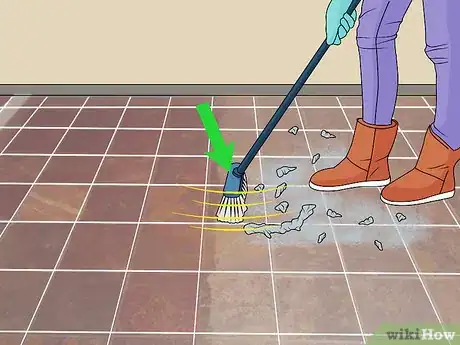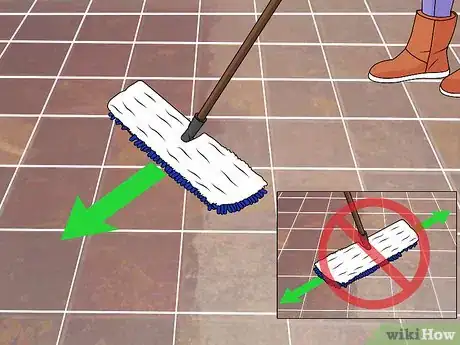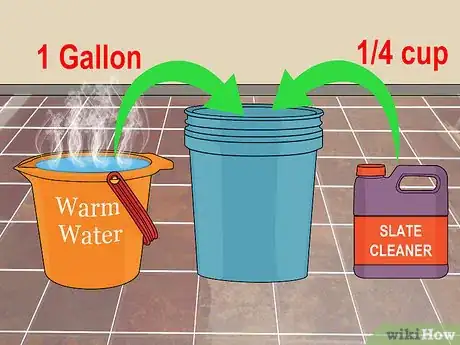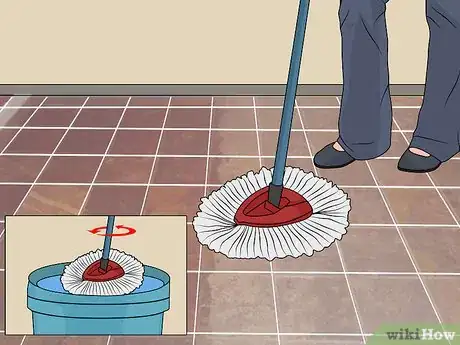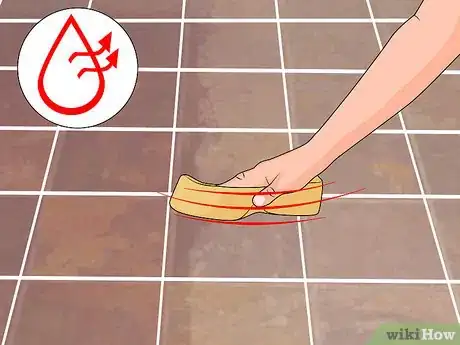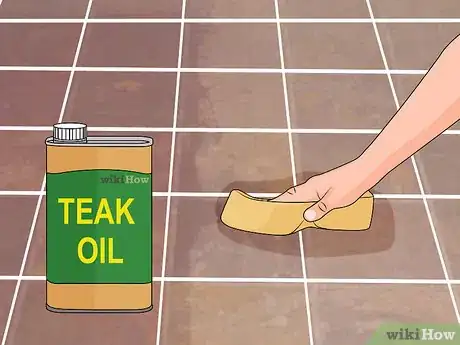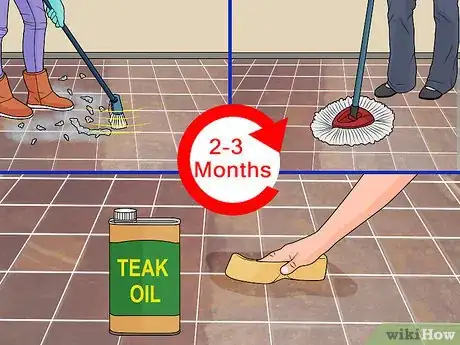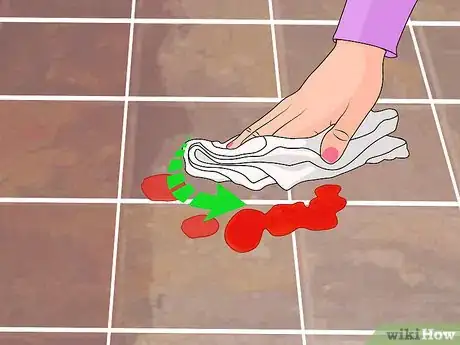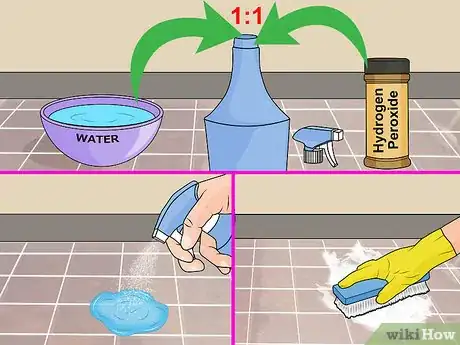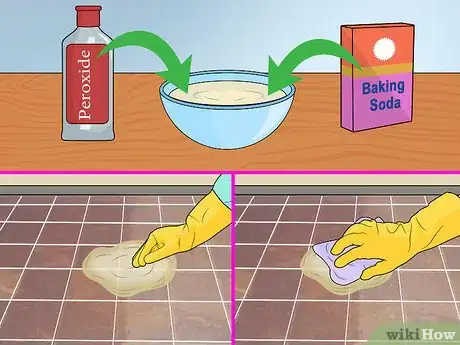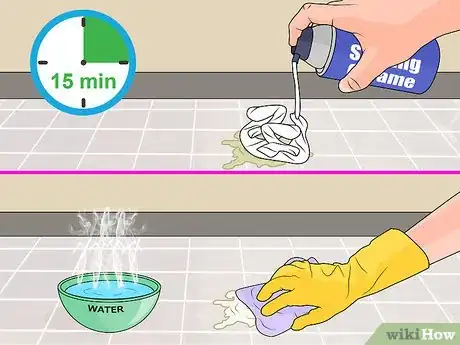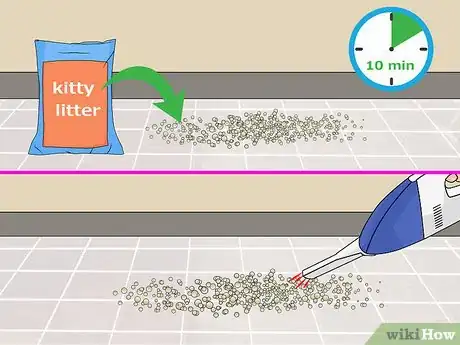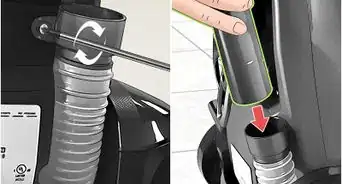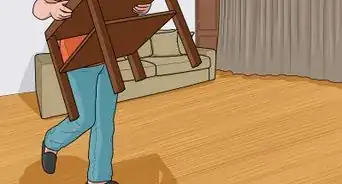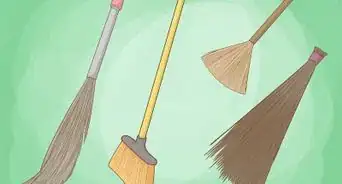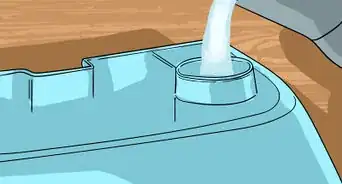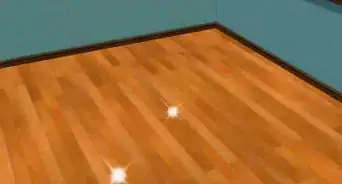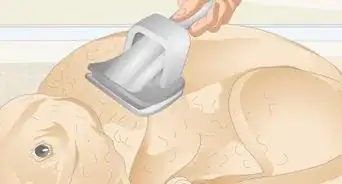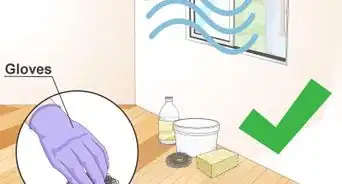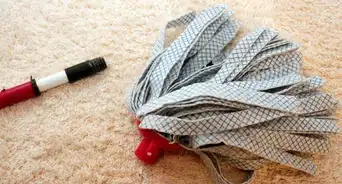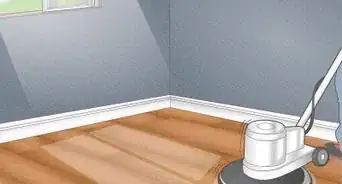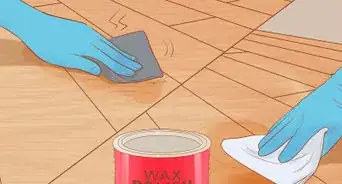This article was co-authored by Jon Gholian. Jon Gholian is a Cleaning Specialist and the Founder of Cleany, a home and office cleaning concierge service based in New York City, New Jersey & Miami. Cleany specializes in providing quality cleaning and handyman services to all their customers. All Cleany employees are insured, bonded, and professionally trained. Cleany has been featured in the New York Times, Bravo & Redfin.
There are 7 references cited in this article, which can be found at the bottom of the page.
This article has been viewed 225,012 times.
While slate floors are attractive, they benefit from regular upkeep. Slate is porous and absorbs stains.[1] It's also very soft and can easily be chipped and eroded by acids and hard scrub brushes. By attacking stains immediately and cleaning with soft mops, you can keep your slate floor vibrant for longer.
Steps
Mopping the Floor
-
1Sweep or vacuum the floor. With a soft-bristle broom, go along the floor, removing any debris. You can also use a vacuum with a brush attachment to get between the crevices. Remember that slate is soft and easily damaged, so you want to choose a brush that is clean and as soft as possible.
-
2Dust mop the floor. Choose a clean dust mop that is not oil-based. Run the mop in one direction over the floor to pick up debris and dust. Avoid moving back and forth, as this will move the dust back onto the slate and cause damage when you clean later.[2]Advertisement
-
3Prepare a water and detergent mixture. In a bucket, combine about a gallon of warm water with 1⁄4 cup (59 ml) of detergent. The detergent should be gentle to avoid abrading the floor. Choose a detergent for delicate clothing or a gentle dish soap.
- Specialized slate cleaners are also an option. These should be non-acidic. Follow the directions on the container.[3]
-
4Mop the floor. Wring out the mop before you start and make smooth strokes. Go slow. Rinse your mop and wring it out often to avoid any debris clinging to it and getting worked into the porous slate.
- Steam mops are also an option. Check the hardware store. These mops pick up extra condensation and dirt.
- Anytime the mop appears to be leaving streaks or debris on the floor, dump out your water and make the water and detergent mixture again.
-
5Dry the floor with a towel. Choose a soft cloth that won't scrape the slate, then wipe off as much water as possible. This will prevent the water from seeping into the pores. Afterwards, let the floor air dry.
-
6Apply teak oil. Once the surface has dried, apply a thin layer of teak oil with a soft cloth. A small amount of oil will ensure a deeper cleaning, but don't apply enough that the slate begins to absorb it.[4]
- Slate oil is also a good choice, but tends to be much more expensive than teak oil.
-
7Repeat cleaning in two to three months. Slate is a very delicate material, so your floor benefits from getting a soap and water wash every few months. This removes grime and prevents stains and the need to perform deeper, more difficult cleaning later.
-
8Use a sealer. Stone and tile sealers are available at flooring retailers and hardware stores. Follow the directions on the label. Use a clean cotton mop to spread the sealer evenly across the floor. This will prevent stains by blocking the pores from spills.
Removing Stains
-
1Wipe up spills immediately. Tackle spills as soon as they happen to avoid any substance getting into the porous surface. Use a soft cloth or towel.[5]
-
2Rub out stains. Choose a clean sponge or a scrub brush with soft, non-metal bristles. Also avoid using any acidic or abrasive cleaners. You can use the warm, soapy water from mopping to scrub the stains.
-
3Use hydrogen peroxide. For floors with non-colored grout only, mix an equal amount of water and hydrogen peroxide into a spray bottle. Spray the mixture on, let it sit for ten minutes, then scrub it off with a soft pad or brush.[6]
- This is a bleach mixture, so it will take the color out of colored grout.
-
4Use peroxide and baking soda. For stubborn stains, mix small amounts of peroxide and baking soda to form a paste. Wait for the bubbles to stop, then put the paste on the stains. Let it set for a few minutes, then wipe it clean with a soft cloth or towel.[7]
-
5Use shaving cream on colored grout. Apply the shaving cream to the stains, let it sit for 15 minutes, then remove it with warm water and a soft towel.[8]
- Remember to try the shaving cream in an inconspicuous spot to make sure it doesn't discolor the grout.
-
6Pour absorbent material on oil stains. Try absorbent materials such as kitty litter. Cover the stain with the material and leave it for ten minutes for a new stain or several hours for an old stain. Carefully vacuum it up when done.[9]
- If repeated attempts don't remove the stain, mix equal amounts of baking soda and water, cover the stain with the resulting paste, and leave the paste on the stain to dry.
- If baking soda doesn't work, pour mineral spirits on the stain, leave it for half an hour, scrub with a stiff brush, then soak with newspaper and wash the area.
- If that doesn't work, spray brake oil on the stain then try the absorbent material again.
Expert Q&A
Did you know you can get expert answers for this article?
Unlock expert answers by supporting wikiHow
-
QuestionWhat is the best mop to use on slate that has small pieces of paint or just plain dirt stuck to it?
 Mark SpelmanMark Spelman is a General Contractor based in Austin, Texas. With over 30 years of construction experience, Mark specializes in constructing interiors, project management, and project estimation. He has been a construction professional since 1987.
Mark SpelmanMark Spelman is a General Contractor based in Austin, Texas. With over 30 years of construction experience, Mark specializes in constructing interiors, project management, and project estimation. He has been a construction professional since 1987.
Construction Professional
-
QuestionWhat is the best cleaner for slate tile?
 Jon GholianJon Gholian is a Cleaning Specialist and the Founder of Cleany, a home and office cleaning concierge service based in New York City, New Jersey & Miami. Cleany specializes in providing quality cleaning and handyman services to all their customers. All Cleany employees are insured, bonded, and professionally trained. Cleany has been featured in the New York Times, Bravo & Redfin.
Jon GholianJon Gholian is a Cleaning Specialist and the Founder of Cleany, a home and office cleaning concierge service based in New York City, New Jersey & Miami. Cleany specializes in providing quality cleaning and handyman services to all their customers. All Cleany employees are insured, bonded, and professionally trained. Cleany has been featured in the New York Times, Bravo & Redfin.
Cleaning Specialist
-
QuestionWhat cleaner should I use on slate floors?
 Community AnswerTo ensure your floors aren't damaged, simply use hot water to clean.
Community AnswerTo ensure your floors aren't damaged, simply use hot water to clean.
Warnings
- Do not use cleaner with acid in it. This includes vinegar. Some laundry detergents are environmentally friendly and work well on slate floors.⧼thumbs_response⧽
- Do not use rubber-backed rugs or mats on slate floors, as the rubber may damage the floor.⧼thumbs_response⧽
- Do not use an oil-based dust mop.⧼thumbs_response⧽
Things You'll Need
- Broom
- Dust mop
- Bucket
- Water
- Cleanser
- Wet mop
- Brush
- Hydrogen peroxide
- Baking soda
- Shaving cream
- Tile sealant
References
- ↑ http://www.stoneworld.com/articles/83080-care-and-maintenance-of-slate-flooring
- ↑ Jon Gholian. Cleaning Specialist. Expert Interview. 3 December 2020.
- ↑ Jon Gholian. Cleaning Specialist. Expert Interview. 3 December 2020.
- ↑ https://www.bobvila.com/articles/how-to-clean-slate/
- ↑ https://dengarden.com/home-improvement/Refinishing-a-Tile-Floor
- ↑ https://secure.img.wfcdn.com/docresources/17924/14/141271.pdf
- ↑ https://www.bobvila.com/articles/how-to-clean-slate/
- ↑ http://www.stylemepretty.com/living/2010/04/13/how-to-clean-grout/
- ↑ https://www.youtube.com/watch?v=SGeTDajlohM
About This Article
To clean slate floors, sweep the floor with a soft-bristle broom or vacuum with a brush attachment. Slate is soft and can be easily damaged, so make sure you choose a brush that is as clean and soft as possible. Mop the floor with a mixture of warm water and a gentle detergent or slate cleaner. Rinse and wring out the mop often to ensure you don’t work dirt into the slate’s porous surface. Dry the floor thoroughly with a clean towel, then apply a small amount of teak or slate oil to the floor. Keep reading to learn how to remove stains from your slate floors.
